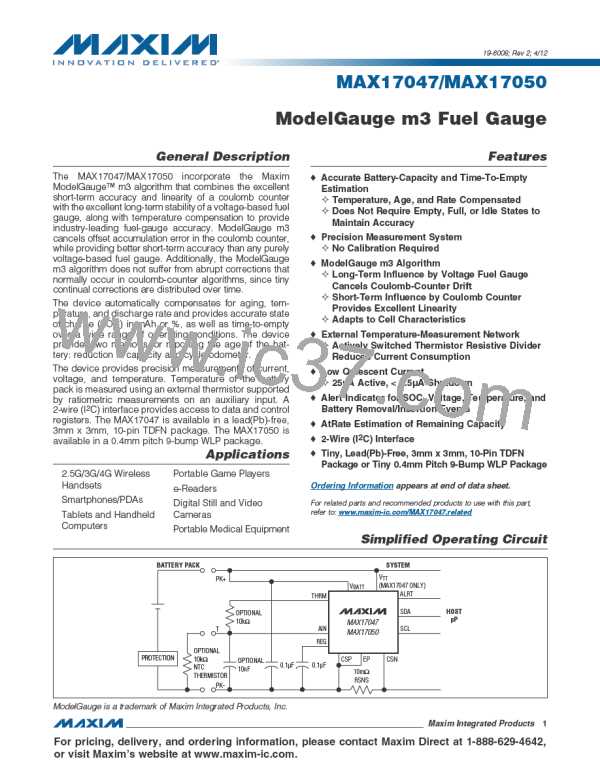MAX17047/MAX17050
ModelGauge m3 Fuel Gauge
VOLTAGE FUEL GAUGE
VOLTAGE
CURRENT
TIME
OCV CALCULATION
OCV TABLE LOOKUP
% REMAINING OUTPUT
COULOMB COUNTER
OCV OUTPUT
mAh OUTPUT
OCV TEMPERATURE-
COMPENSATION LEARN
RELAXED
CELL
DETECTION
CAPACITY LEARN
mAh PER %
MIXING ALGORITHM
mAh OUTPUT
EMPTY
DETECTION
RemCap
MIX
SOC
MIX
CURRENT
APPLICATION
EMPTY
COMPENSATION
TEMPERATURE
APPLICATION
OUTPUTS:
CELL CHEMISTRY
OUTPUTS:
SOC
RemCap
OCV
CYCLES
REP
REP
END-OF-CHARGE
DETECTION
SOC
RemCap
TTE
R
AV
CELL
FullCAPNom
AGE
AV
FullCAP
Figure 2. ModelGauge m3 Overview
observed over time in the actual application, the error in
the system is boundless. The performance of classic
coulomb counters is dominated by the accuracy of such
corrections.
combined result eliminates the weaknesses of both the
coulomb counter and the VFG, while providing the
strengths of both. A mixing algorithm combines the VFG
capacity with the coulomb counter and weighs each
result so that both are used optimally to determine the
battery state. In this way, the VFG capacity result is used
to continuously make small adjustments to the battery
state, canceling the coulomb-counter drift.
Classical voltage-measurement-based SOC estimation
has poor accuracy due to inadequate cell modeling, but
does not accumulate offset error over time.
The device includes an advanced VFG, which estimates
open-circuit voltage (OCV), even during current flow, and
simulates the nonlinear internal dynamics of a lithium-ion
(Li+) battery to determine the SOC with improved accu-
racy. The model considers the time effects of a battery
caused by the chemical reactions and impedance in the
battery to determine SOC based on table lookup. This
SOC estimation does not accumulate offset error over time.
The ModelGauge m3 algorithm uses this battery state
information and accounts for temperature, battery cur-
rent, age, and application parameters to determine the
remaining capacity available to the system.
The ModelGauge m3 algorithm continually adapts to the
cell and application through independent learning rou-
tines. As the cell ages, its change in capacity is monitored
and updated and the VFG dynamics adapt based on cell-
voltage behavior in the application.
The ModelGauge m3 algorithm combines a high-accu-
racy coulomb counter with a VFG. The complementary
����������������������������������������������������������������� Maxim Integrated Products
9

 MAXIM [ MAXIM INTEGRATED PRODUCTS ]
MAXIM [ MAXIM INTEGRATED PRODUCTS ]